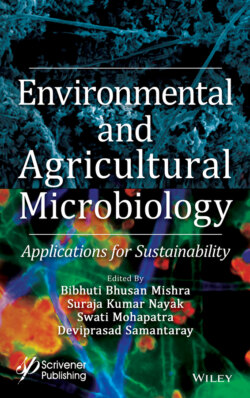Читать книгу Environmental and Agricultural Microbiology - Группа авторов - Страница 10
Оглавление
Preface
The indiscriminate use of agrochemicals, resulting in an increasing concentration of synthetic contaminants in the environment, is a matter of great concern across the globe. These chemicals or their toxic intermediates enter into the food chain and are subjected to biomagnifications. Moreover, contaminants from industrial discharges like effluents, solid waste and exhaust air, radioactive substances, hydrocarbons, etc., worsen the scenario. The sustainability of the ecosystem is strongly influenced by the microbial community from natural resources. The pivotal role played by microbes in effectively degrading these environmental contaminants may even be better than conventional methods. Microbes’ innate capacity allows them to degrade, utilize and/or transform a plethora of both organic and inorganic substances, including persistent and recalcitrant agrochemicals, metals and minerals and different xenobiotic polymers which have been successfully used for remediation of pollutants in the biosphere.
In the agricultural milieu, application of microbes is the focus of the day, with an emphasis on plant-microbe interactions. These interactions are complex and may be antagonistic, mutualistic or synergistic, depending on their microbial diversity and association with the host and environment. With the involvement of microbes, complex chemical substances essential for sustaining life are being transformed into available forms that are easily absorbed by plants. In addition, microbes are also involved in biofortification of elements through recycling, resulting in enhanced growth and productivity.
Though books pertaining to soil and agricultural microbiology/environmental biotechnology are available, there is a dearth of comprehensive literature on the behavior of microorganisms in the environmental and agricultural realm covered in this book, which makes it unique. This book is divided into two parts, with chapters that embody the sustenance and life cycles of microorganisms under various environmental conditions, their dispersal, interactions with other inhabited communities, metabolite production and reclamation. Part 1 of the book includes topics on bioremediation of agrochemicals by microalgae, detoxification of chromium and other heavy metals by microbial biofilm, microbial biopolymer technology, including polyhydroxyalkanoates (PHAs) and polyhydroxybutyrates (PHB), their production, degradability behaviors and applications. Biosurfactants production and their commercial importance are also systematically represented in this part. In Part 2 of the book, imperative ideas are presented on approaches for sustainable agriculture through functional soil microbes, next-generation crop improvement strategies via rhizosphere microbiome, production and implementation of liquid biofertilizers, mitigation of methane from livestock, chitinases from microbes, and extremozymes (enzymes from extremophilic microorganisms). Their relevance in current biotechnology, lithobiontic communities and their environmental importance are comprehensively elaborated. Since this is the era of sustainable energy production in which biofuel and other bioenergy products play a key role, also covered is their production from microbial sources—considered the new frontier for researchers. The concluding chapter reveals the importance of microbes and their consortia for management of solid waste in combination with biotechnology.
Because the field of environmental and agricultural biotechnology/ microbiology is so large and appeals to those with varied interests, in order to make the topics covered herein more useful, informative and relevant to a vast range of readers, a broad array of current advances is covered in chapters that are supplemented with illustrative diagrams and informative tables, along with the future prospects of microorganisms. Therefore, doctoral and post-doctoral fellows working in the area, and environmental microbiologists and chemical engineers who want to delve into the largely unexplored realm of microorganisms in benign, beneficial agricultural production and environmental remediation will be exposed to the latest findings in these research frontiers in a comprehensive manner. Moreover, readers will be provided with key knowledge on cutting-edge biotechnological methods applied in soil and environmental microbiology.
The editors express their sincere gratitude to all contributors for their excellent cooperation, critical thoughts and contributions that helped to complete this timely edited volume. We also sincerely thank Scrivener Publishing for providing us with a platform to publish this book. Last but not least, we wish that the current and upcoming scientific generations will use the knowledge presented herein for the benefit and development of society. We will definitely appreciate any comments on the book for future consideration.
Bibhuti Bhusan MishraSuraja Kumar NayakSwati MohapatraDeviprasad Samantaray June 2021
